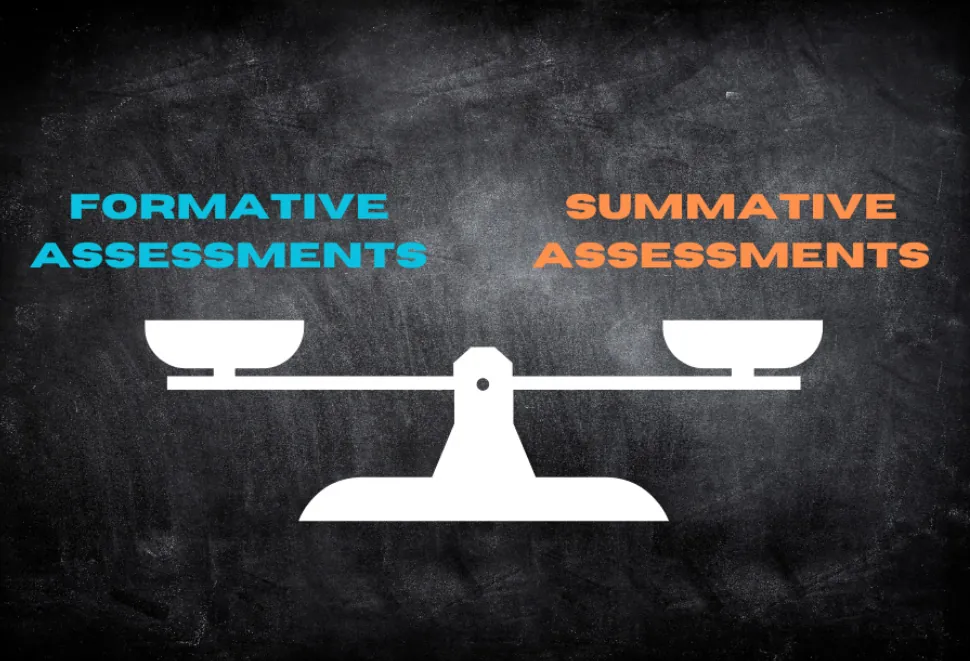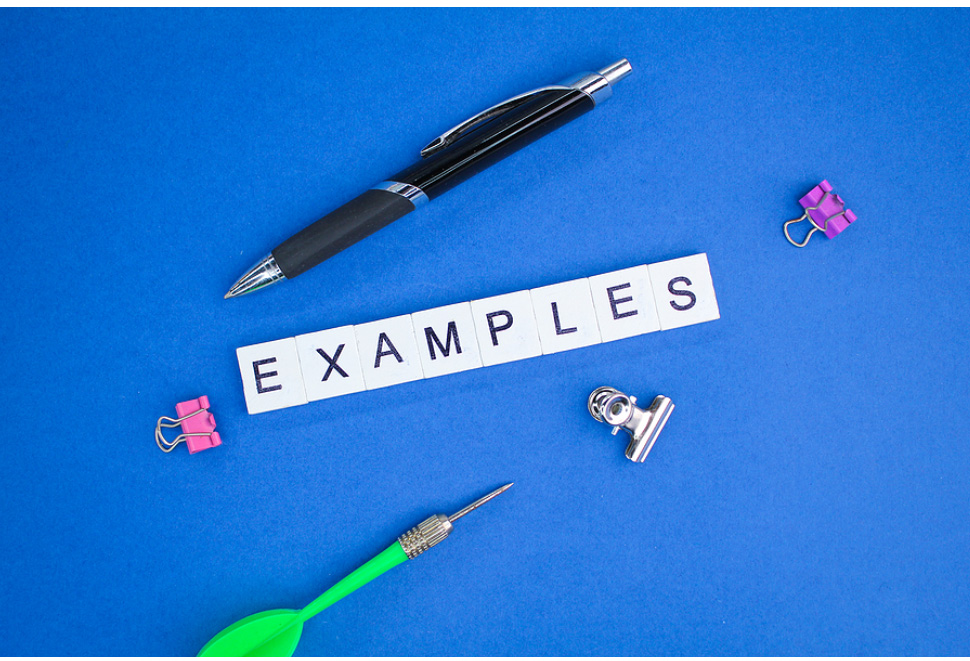
When assessing student learning, two of the most common approaches are formative and summative assessments.
One of the primary benefits of using formative and summative assessments is that you aren’t forced to choose between them. They work exceptionally well when used in combination.
In this article, we’ll be breaking down precisely what formative and summative assessments are, the key differences between them, the benefits of their use, and providing a range of examples to help illustrate how they can be implemented in the classroom.
If you’re looking for an effective way to assess student learning and measure progress, read on to find out how formative and summative assessments can help.

Learn How To Create Personal Learning Journeys For FREE!
Formative Assessments: Definition and Purpose
Before we get into examples of their use, it’s essential that we first define precisely what both formative and summative assessments are and how they differ.
Formative Assessments: Definition and Purpose
Formative assessments are employed regularly throughout a set learning period, be that a chapter, unit, or term, and help track progress and identify areas where students may struggle or need more support.
They also give the teacher and course designer the data they need to improve the learning experience and make any necessary changes that may be required throughout a system.
Rather than strict exams, formative assessments are usually relatively low-stakes, meaning they do not always need to be graded or even marked. This helps to create a non-threatening atmosphere and encourages students to take risks in their learning without fear of failure.
Formative assessment tasks usually rely on feedback from both students and the teacher, with learners receiving feedback on performance as soon as possible.
Uses of Formative Assessments
As mentioned, one of the primary uses of a formative assessment is to gauge student understanding and identify knowledge gaps that may need extra work.
Formative assessments can also be used to help inform curricular decisions, provide valuable data on the effectiveness of a course or lesson, and allow students to monitor their progress over time.
In addition, formative assessments are valuable in helping teachers gain real-time insight into a group’s collective understanding, allowing them to rapidly adapt their training or lessons accordingly.
Benefits of Using Formative Assessments
There are a range of benefits to employing formative assessments as part of your teaching strategy, including the following:
- Improved student or employee engagement and motivation – By allowing students to track their learning journey, you can help them take ownership of their learning experience. This can be highly motivating for students, as it encourages a sense of progress and accomplishment.
- Better assessment of real-world understanding – By using formative assessments that involve practical skills or application, you can better understand how well your students understand the real-world implications of the content they are studying.
- Enables rapid identification of areas of difficulty for learners – Through formative assessments, you can quickly identify areas that students may be struggling with. This helps to ensure that these areas are addressed rapidly and effectively.
- Allows teachers to tailor their lessons to the needs of the group – Teachers and course designers can use the data from formative assessments to tailor their studies according to the group’s needs and ensure that they meet all learning objectives.

Examples of Formative Assessments
To clarify how formative assessments can be used, below are a few examples of tasks that could be used both in the classroom and in a digital learning environment.
Classroom-Based Examples
The following examples can be valuable to employ in a classroom setting:
1. Quizzes and polls
Simple and easy to execute, quizzes and polls are a low-effort way of gauging student understanding at regular intervals throughout a lesson.
2. Peer feedback and self-assessment
Peer-based feedback sessions and self-assessment questionnaires can help identify areas where students may need extra support or guidance while giving vital insight into how students perceive their progress.
3. Class discussions and debates
Encouraging students to discuss their different perspectives on a given topic or concept allows teachers to better understand how well they comprehend the material. It also gives students the opportunity to have their ideas heard and helps create a sense of solidarity within the classroom.
Online and Digital Examples
With the rise in the use of digital learning tools and technologies, there is also a range of online-based practices that can be used as formative assessments, including:
1. Interactive quizzes and games
The gamification of quizzes or other learning activities can provide an engaging way to assess student understanding and offer real-time feedback.
2. Virtual simulations and case studies
Where more vocational skills are being taught, virtual simulations and case studies can test students’ problem-solving capabilities in a low-stakes environment.
3. Online discussion forums and feedback platforms
One of the benefits of using an online learning platform is the wide range of features available to assess student understanding. Discussion forums, peer feedback platforms, and automated feedback systems can all be used as formative assessment tools.

Summative Assessments: Definition and Purpose
Compared to formative assessments, summative assessments are conducted at the end of a defined learning period and often represent the final grade for the course.
To provide a comprehensive assessment grade, summative assessments evaluate a student’s overall understanding and performance of the skill or concept studied.
They can also be used to track educational progress over time, such as in standardised testing, as well as help to inform curricular decisions and the effectiveness of teaching methods.
Uses of Summative Assessments
Summative assessments test student mastery of content, assess their overall understanding of a subject or topic area and generally give them a final mark.
For teachers and course designers, a summative assessment allows them to measure the effectiveness of their teaching and make any necessary changes or improvements.
Summative assessments can also be used to compare student performance across different classes, courses, and programs.
Benefits of Summative Assessments
As with formative assessments, there is a range of benefits associated with the use of summative assessments, including:
- Provides an overall assessment score – Summative assessments can provide a more accurate assessment of student understanding and performance, offering an overall grade or score.
- Helps track educational progress over time – Educators can track student progress to identify improvement areas through standardised testing or other summative assessments.
- Helps inform curricular decisions – Summative assessments can assess the effectiveness of a particular course or program and help inform future curricular choices.
- Offers an efficient way to measure learning outcomes – By providing an overall assessment grade, summative assessments offer a convenient way to measure the success of a teaching strategy in one go.

Examples of Summative Assessments
To clarify how summative assessments can be implemented, here are a few examples of traditional assessment methods, such as essays and exams, and performance-based assessments, such as presentations and projects.
Traditional Assessment Methods
Below are some examples of traditional assessment methods:
1. Examinations and final tests
Examinations are widely used to assess student knowledge and understanding at the end of a course or program. They are easy to implement and provide a quick and efficient way to evaluate student performance.
2. Term papers and essays
Essays and term papers are another traditional assessment method used alongside examinations. Essays test students’ ability to analyse a given topic or concept in detail, providing insight into their understanding of the subject matter.
3. Projects and presentations
Where skill-based or vocational courses are being taught, projects and presentations can test a student’s performance in class. These assessments allow students to demonstrate their understanding of the subject matter and show their ability to apply and transfer the knowledge in a practical context.
Performance-Based Assessments
Performance-based assessments are best employed when assessing practical skills or processes. Examples of performance-based summative assessments include:
1. Practical exams and demonstrations
Practical tests and demonstrations are often used to assess students’ physical abilities, such as in sports or vocational courses. These assessments test a student’s understanding of a particular skill or concept by having them demonstrate it in a real-world setting.
2. Portfolios and showcases
Where creative or design-based courses are being taught, portfolios and showcases allow students to demonstrate their understanding of the concepts in a practical way. These assessments require students to use their creative skills to produce a tangible output, such as an artwork or multimedia presentation.
3. Capstone projects and dissertations
Dissertations and capstone projects are often used to assess students’ understanding of complex topics or skills. These assessments require students to demonstrate their knowledge of the subject matter by producing an in-depth research or project that meets specific criteria.
Critical Differences Between Formative and Summative Assessments
Now that you have a fuller understanding of what both formative and summative assessments represent and how they can be employed, here’s a summary outlining the key differences between the two:
Timing and Frequency
One of the most essential distinctions between the two types of assessment is when they are conducted. Formative assessments occur throughout the course and act as checkpoints to monitor student progress.
In contrast, summative assessments are shown at the end of a defined learning period and only count towards an overall grade or score.
Purpose and Focus
Formative assessments are designed to provide feedback on understanding and inform instruction in real-time. In contrast, summative assessments evaluate student performance of a skill or concept and can help inform curriculum decisions.
Feedback and Evaluation Process
The feedback and evaluation process for formative and summative assessments differs significantly. Formative assessments are designed to offer real-time feedback on performance.
In contrast, summative assessments provide an overall assessment score or grade that reflects the student’s understanding of the subject matter at the end of a course or program.

Which is the Right Assessment Approach to Utilise?
Choosing the correct assessment approach for your students ultimately depends on the goals you are trying to achieve, the type of course or program being taught and the knowledge and skills that need to be assessed.
To help you decide, consider the following:
Considerations for Selecting Formative Assessments
Some of the critical considerations for making use of formative assessments include:
- Regular feedback – Formative assessments should be implemented regularly to ensure students receive regular feedback on their understanding and performance.
- Low-stakes testing – As formative tests don’t count towards an overall grade, they should be designed as low-stakes tests to help encourage participation.
- Inform instruction – Formative assessment results can inform instruction in real-time, allowing educators to tailor their teaching approach to student needs.
Considerations for Selecting Summative Assessments
When making use of summative assessments, it’s essential to consider the following points:
- Assessment goals – Before designing a summative assessment, clearly define the purposes of the evaluation and how it will be used to evaluate student performance.
- Assessment criteria – When creating a summative assessment, ensure that you set clear and concise evaluation criteria that allow students to demonstrate their understanding fully.
- Inter-rater reliability – To ensure fairness and accuracy, consider having multiple assessors score each student’s work when creating a summative assessment.
Using Both Formative and Summative Assessments in Learning and Development
As mentioned, one of the primary benefits of using formative and summative assessments in learning and development is that they can provide a more comprehensive evaluation of student performance.
By implementing both assessment forms, educators can better understand their student’s progress and tailor their instruction for maximum impact.
Formative assessments can measure progress and inform instruction in real-time, while summative assessments provide an overall score or grade that indicates learning success.
Final Thoughts
While formative and summative assessments have apparent differences, such as in their purpose, timing and feedback mechanisms, there are significant benefits to using both assessment types in learning and development.
Educators can better assess student performance and tailor instruction by implementing formative and summative assessments. Additionally, the use of both reviews provides a comprehensive view of understanding that can be used to inform curriculum decisions.
If you are looking for more guidance and resources on creating and implementing formative and summative assessments, check out the other articles on the Skillshub blog.
As an eLearning company, we are committed to creating efficient and impactful learning experiences. Our team are experts in developing eLearning content, so skillshub can help create customised learning materials tailored to your organisation’s needs. To learn more about our services, get in touch with us today.














